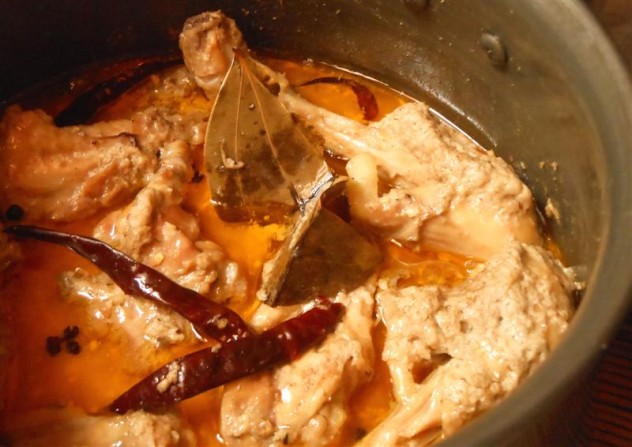When the poet-king Nawab Wajid Ali Shah – the tenth and last nawab of Awadh – was exiled to Calcutta in 1856, he was followed by a large retinue of relatives, musicians, khansamas (stewards), bawarchis (cooks who prepared large quantities of food), rakabdars (gourmet chefs) and moshalchis (mixers of spice) who accompanied the heartbroken nawab to live with him in exile. The banished nawab took up residence in Metiabruz along the banks of the river Hoogly – a place that was to become a miniature Lucknow, whittled from the dreams of his beloved city.
After the death of Wajid Ali Shah, the royal cooks who carried with them the Awadhi legacy gradually diffused into the local population introducing the refined flamboyance of the Awadhi cuisine to the rare exuberance of the Bengali palate. The rezala – a mild yogurt-based meat stew – is Awadh's gift to Bengal.
Unlike Mughlai cuisine which is veritably rich and known for its use of varied and exotic spices, Awadhi cuisine in which the food is cooked over a slow fire is considerably milder. While Awadhi cuisine retains a veritable Mughlai influence, its own distinctive flavors sets it apart from the baroque splendors of the Mughlai culinary repertoire. A luscious meat stew flavored with yogurt, cashew nuts and clarified butter, the rezala embodies the delicate astuteness of the royal Awadhi kitchen. It strikes a perfect balance between sour and sweet, tickling the palate, drowning the intense aftertaste of meat in a lingering velvety delirium. A finely-cooked rezala does not overwhelm but gently stimulates the senses. Amidst the subdued incandescence of fiery peppers tempered further with the delicate relish of yogurt and cashew nuts, the sinewy tenderness of the meat measures out a rare delight. And, quivering in the midst of it all, like a straying tune from the lover's lute, rings the poet king's plaintive requiem for his beloved Lucknow:
"Babul mora, naihar chhooto hi jaye…" [roughly translated from Hindi as: 'Oh my dear father, I am leaving my home behind…']
More than a century and half later, the rezala – albeit its very many incarnations – continues to delight; its old-world charm hardly obscured by the soaring glories of the global kitchen.
Here's a recipe:
1. 1 kilo mutton (a combination of shoulder and foreshank) or chicken (a combination of thigh and breast)
2. Juice of 4 large red onions (you may preserve the pulp for later use)
3. 5-6 fat cloves of garlic
4. 1 tsp juice of ginger (freshly extracted)
5. 250 gms thick creamy yogurt or hung curd (not too sour)
6. 1tbsp raw papaya paste (peel included; not required if you are using chicken)
7. 2 tbsp cashew paste
8. 8-10 peppercorns
9. 8-10 whole dry red chilies
10. 3-4 bay leaves
11. 4 green cardamoms (crushed lightly)
12. 2 sticks of cinnamon (each about an inch)
13. Clarified butter/ Cooking butter/ Vegetable oil for cooking
14. Salt and sugar to taste
15. A cup of warm, full-fat milk (optional; my addition)
Marinate the meat overnight with items 2-6. Keep covered and refrigerate (do not put inside the freezer).
The marinated meat should be brought back to room temperature before cooking.
Heat clarified butter/ cooking butter/ vegetable oil in a large heavy-bottomed wok and season with items 9-12. Add the marinated meat (after salting) to the crackling, aromatic spices and cook over a high flame stirring frequently until the the oil separates. Put in the cashew paste and cook for about 40 seconds until well blended. Add enough warm water (along with the milk if you are using it) for the meat to cook over a slow fire. Put in the peppercorns, more salt (if required; but only after the gravy has come to a boil) and sugar to taste. Use a well-fitting lid to cover the wok. Cook over a slow fire until done. Once the meat is tender, add a dollop of butter and serve with naan or basmati rice.


I tried the recipe and it was a huge success with many requests for second helpings. I added some saffron with the hot milk towards the end. The end result was a triumph. Loved the introduction and interesting background to this most favourite of dishes. You have such a flair for food, and your food stories are real treasures.